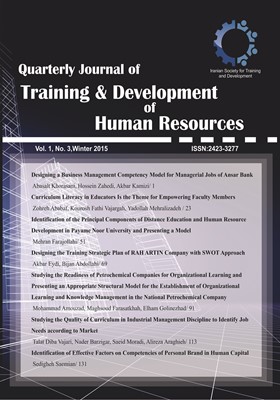-
-
List of Articles
-
Open Access Article
1 - Designing a Business Management Competency Model for Managerial Jobs of Ansar Bank
حسین زاهدی -
Open Access Article
2 - Curriculum Literacy in Educators Is the Theme for Empowering Faculty Members
زهره عباباف یداله مهرعلیزاده -
Open Access Article
3 - Identification of the Principal Components of Distance Education and Human Resource Development in Payame Noor University and Presenting a Model
مهران فرجاللهی -
Open Access Article
4 - Designing the Training Strategic Plan of RAH ARTIN Company with SWOT Approach
akbar eydi -
Open Access Article
5 - Studying the Readiness of Petrochemical Companies for Organizational Learning and Presenting an Appropriate Structural Model for the Establishment of Organizational Learning and Knowledge Management in the National Petrochemical Company
Mohammad عموزاد -
Open Access Article
6 - Studying the Quality of Curriculum in Industrial Management Discipline to Identify Job Needs according to Market
طلعت دیبا نادر برزگر سعید مرادی -
Open Access Article
7 - Identification of Effective Factors on Competencies of Personal Brand in Human Capital
دکتر آذر صائمیان
-
The rights to this website are owned by the Raimag Press Management System.
Copyright © 2017-2026







